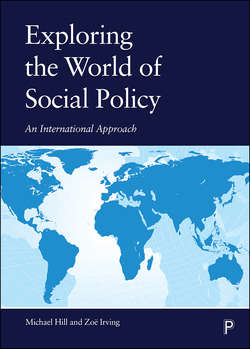Читать книгу Exploring the World of Social Policy - Hill Michael - Страница 5
На сайте Литреса книга снята с продажи.
ОглавлениеList of figures, tables and boxes
Figures
2.1 Regional and selected country percentage of global total wealth (US$ trillion), 2000 and 2018
5.1 Income security expenditure in the context of general social expenditure in OECD countries, 2016
5.2 Pensions as a percentage of income support expenditure
5.3 Public pension choices
6.1 Countries with migrant remittances inflows of 10 per cent or more of GDP (US$ millions), 2018
7.1 Public and private expenditure on primary, secondary and post-secondary, non-tertiary education as a percentage of GDP in OECD countries, 2015
7.2.Education expenditure and social expenditure as a percentage of GDP, 2015 or latest available
7.3 Percentage of tertiary graduates, 2016
8.1 Percentage share of households by housing tenure, 2014 or latest available
8.2 Public spending on grants and financial support to home buyers as percentage of GDP, 2015
9.1 Health expenditure per capita, 2016 or nearest year
10.1 Expenditure on early childhood educational development and pre-primary education, 2015
10.2 Population aged 65+, 2017 (% of total population)
10.3 Long-term care expenditure (health and social components) by government and compulsory insurance schemes, as a share of GDP, 2015 or nearest year
12.1 Real GDP growth, annual percentage change, 2006–20
Tables
1.1 Differentiated life expectancy at birth
4.1 Sources of policy convergence
5.1 Taxonomy of social assistance systems
5.2 The World Bank Report’s Pension Pillars
6.1 Labour market expenditure as percentage of GDP
6.2 Distribution of migrant workers by world sub-region, 2015
7.1 Education expenditure as a percentage of GDP, selected countries
7.2 Northern European divergence in models of education provision
7.3 Gaps in school enrolment by region and gender
8.1 Proportion of urban population living in slum areas, 1990 and 2010
9.1 Mortality statistics for the WHO regions, 2015
9.2 Five types of OECD health care systems
10.1 Care through the stages of the life course
10.2 A typology of systems highlighting alternative approaches to care
11.1 The four ‘faces’ of environmental states
11.2 Typology of ‘environmental’ states
11.3 Deaths per 100,000 people attributed to forms of pollution, 2012 by WHO region
11.4 CO2 gas emissions: metric tonnes per capita, 2014
12.1 World union density change, 2006–16
Boxes
5.1 Distinguishing between national income security systems
6.1 ILO definition of unemployment
11.1 IPCC identification of key risks associated with climate change
